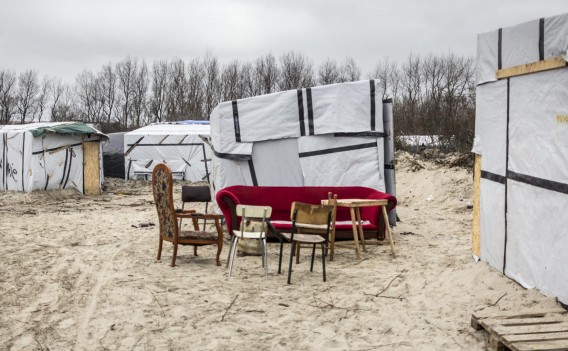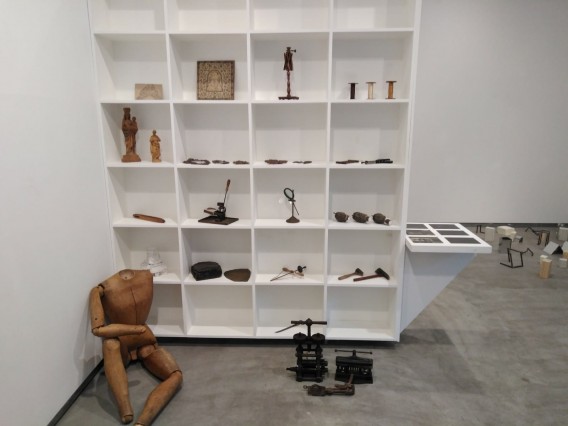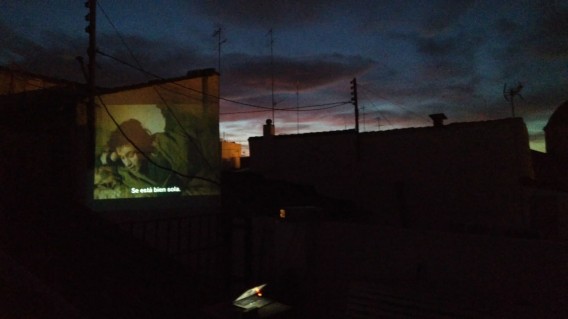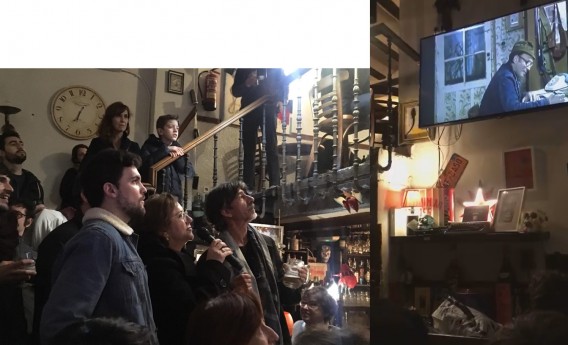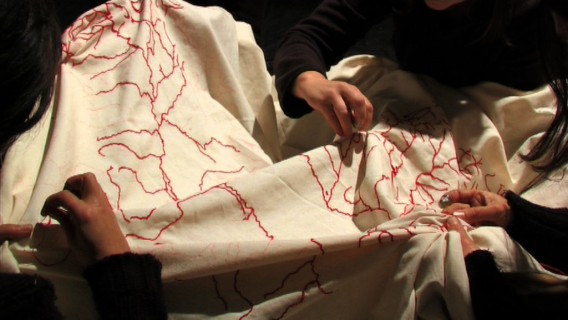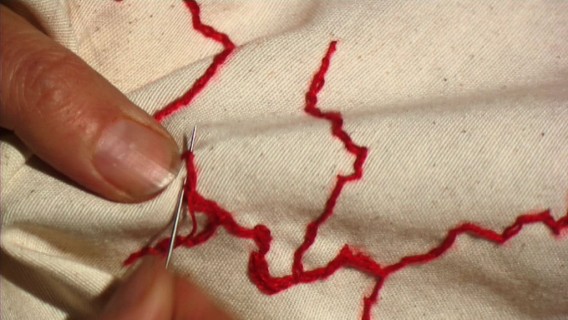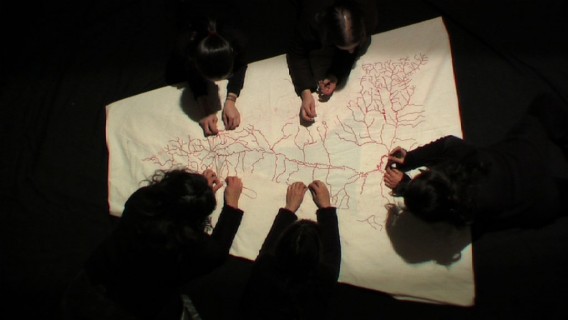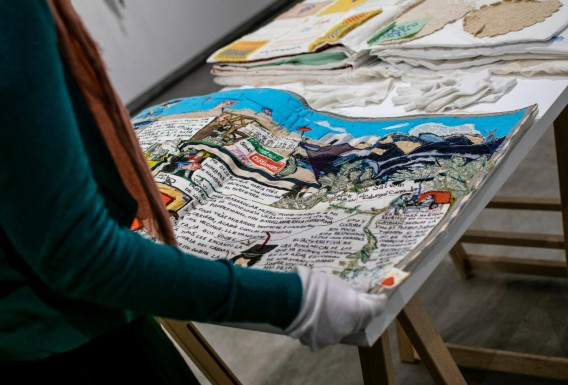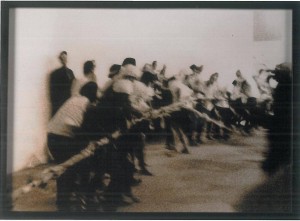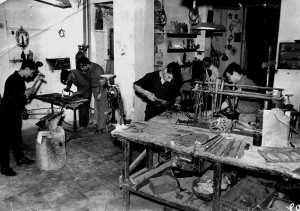Are there hierarchies between the images? We think that they are determined by the organizational models applied to their thinking, creation and dissemination. At La Posta Foundation we follow an organizational model that dilutes the differences between inside and outside the organization. As stated in the letter of presentation of La Posta ―on this website―: ” La Posta Foundation is a nonprofit organization that bases its strength in establishment relationships with partners who work for their own benefit sharing common goals”. This indifferentiation between inside and outside of the organization is reinforced by the fact that, in the development of concrete projects, the differences between thinkers, creators and diffusers of the images and the audience to which they would be directed are diluted, because the latter actively participates in the whole process; an audience that often did not exist prior to the start of the project, but rather it is an audience that emerges with the development of the same and participates in the thought, creation and dissemination of the images. What we call the public to come.
To start this summary of the “subplots of the image” in the 2018-2019 season, nothing better than starting with “Sur” (2004) by Teresa Lanceta (from the series Sewn Paintings), which could be seen in the context of the exhibition “Feminist plots” organized by the LABi team (a project of the Master in Photography, Art and Technique of the Polytechnic University of Valencia in collaboration with La Posta Foundation). Teresa Lanceta lives in Mutxamel, a small town in the valley of Montnegre (the avenue that supplied the Orchard of Alicante), a well-loved place of “the attorneys” of La Posta.
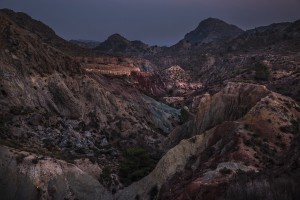 Badlands, Montnegre Valley. Foto Miguel Lorenzo
Badlands, Montnegre Valley. Foto Miguel Lorenzo
For the rest, all the information about the exhibition “Feminist Plots” is in this same web page [simply to advance that in the exhibition it was possible to see, in addition to the work of Teresa Lanceta to whom reference has been made, works by Bia Santos, Miriam Martínez Guirao, the collective artistic project CraftCabanyal, Anabel Mateo and Jessica Espinoza, with the special participation of Eva Viera], but it is not the purpose of this summary to reproduce all the contents, but, what interests us now is to follow the thread to the plot.
More plots. In the staging of the work of Anita Pouchard Serra “Latent Urbanities”, which could be seen in the context of the exhibition “Transiting Frontiers”, organized by the LABi team (a project of the Master in Photography, Art and Technique of the Polytechnic University of Valencia in collaboration with La Posta Foundation), incorporates photography, drawing, video … and a sort of foulard, which seems a vestige of something that could have happened in the New Jungle migrant camp in Calais, to which refers to the set of this work. This fabric has brought to mind a work by Tunga, the Brazilian artist who died a few years ago. Specifically “Teresinha” (1999), a work that has been seen in Spain (in the EACC of Castellón), and that was very present in the first documents with which La Posta was built. The Tunga work is a vestige of a practice probably of Terezinha, State of Pernambuco, in Brazil (gives us a clue the name of the work). This refers to the photograph included in the installation, in which you can see men and, apparently, women too ―it is not safe because the image offered by Tunga is not very clear―, which pulls the two extremes of a thick rope (that practice is also very popular in Spain). A vestige is a sign or trace that remains of something or someone who has passed or who has disappeared. Bringing it to our view aims to activate the memory.
In the exhibition “Transiting frontiers” we could also see works by Odette Fajardo, Marina Alvarez-Dardet Colomer, Fermín Jiménez Landa, Esmeralda Pérez Tamiz and Anja Krakowski. All the information about this LABi exhibition is on this website.
Plots and subplots. The other major exhibition organized by the LABi team this year (composed by Karol Hincapié, Gabriela Rivera Lucero, Andrés Holguín, Gabriella Falcone, Estíbaliz García Taboada and Dolors Fabra Antón) “Suspended places. Revitalizing urban identities”, with works by Pepa L. Poquet and Pau Figueres. Posed as a dialogue with the Carmen neighborhood and the transformations that the historic city undergoes, it put us in contact with the March workshop-house in Mare Vella Street. The March workshop has always been a place of artistic work, dedicated to silk, sculpture or imagery, metalwork and enamels on metal and ceramics. The pieces on display brought from the March workshop on the occasion of the exhibition “Places suspended. Revitalizing urban identities”, some are finished works, but there is an abundance of tools, which remind us of the process of making these works, and, what is more important, they bring to mind the concept of workshop as understood in the past, associated with the learning process. Because the March workshop has always been a workshop-school. La Posta Foundation feels in the pedagogical tradition that has housed the area in which the March workshop is located, particularly applied to the field of arts conceived as a work, such as the one magnificently represented by the March workshop. In this sense, we embrace the idea of the workers’ artist, the one of the workshops and studies in which the apprentices were taught, in a guild context that now has to necessarily give rise to new forms of grouping and community.
Although, if there is a section of our programming that shows a remarkable vigor in terms of thinking and working on the “subplots of the image”, this is the one dedicated to Cinema to come, which this year celebrated its sixth edition: “This is not a movie”. From the title of this edition, taken from a non-documentary film by Jafar Panahi and Mojtaba Mirtahmasb, which portrays the experiences of the former, under house arrest during filming. The electronic file that contained it was smuggled into the Festival of Cannes 2011 on a pen hidden in a birthday cake, and what was not a film became a film by the work and grace of the institution in which it was screened before the public. Against this background, the first objective that is proposed Cinema to come, and by extension an important part of the activities of La Posta, is to dilute the differences between public spectator and image makers. A good example of this has been, within the set of activities included in this edition of Cinema to come: “Take the film elsewhere”, workshop and film-performance conducted by Sofia Asencio, which took place at the Carme Center, La Posta Foundation and the Carmen neighborhood. “In this workshop I propose an experimental work around a film and the ways of seeing it. We are going to divide it into fragments and we will decide in which places those fragments will be projected. This will generate a transit parallel to the film. In this journey, which I would call taking the film elsewhere, we will focus on the possible relationships that are generated, as a prism that triggers new senses” (Sofía Asencio).
The rest of the activities that have been part of the programming of this season both Cinema to come and La Posta in general have been: the exhibition of Virginia García del Pino, “Exhibition documentation from Cinema to come workshops” and “Action Files. Collective self-productions of Cinema to come”; the exhibition of CASA ―the pedagogical project of Ricardo Cases and Pablo Casino (with works by Laura Donate, Blanca Sanfélix, Ana R. Leiva, Elisa López, Felipe Rodriguez and Florent Lucas)―, “Self Made” (exhibition of Beccy Strong’s work in progress with transgender man Kay Jane Browning), “Against the tide processes: Inner Nature in glocal dialogue”, an initiative of Estela López de Frutos, Lorena Rodríguez Mattalía and Chiara Sgaramella, within the framework of the Art and Environment Research Center (works by Ronnie Karfiol, Johanna Reich, Roosje Verschoor, Lucía Loren and Juanma Valentín [see footnote], Nobina Gupta, Pat van Boeckel, Anna Day, Despina Economopoulou, Antonia Bañados, Kim Jin Kook, Clare Charnley & Patricia Acevedo and Hugh Livingston were exhibited), “Inflexive Speeches”, an initiative of Nomadic Network and Yvonne Andreini (with works by this last, by Ulrike von Gültlingen, Alessio Castagna and Caroline Corleone), and the exhibition with which this season has been closed “Protesta tecnobarroca”, by Felipe Rivas San Martín (with the support of Andrés Holguín and Dolors Fabra); all of them show the mobilization of people and resources almost all over the world, involving all types of individuals and organizations, whose typology responds not only to the traditional dichotomy between public/private, but also ―in one case and in another―, becoming a manifestation of organizational forms that unfold and multiply in a kind of development that can be confusing for those outside, being the first reason for confusion to determine precisely who is inside. More than 56 people with names and surnames incorporated into the activities of La Posta directly or with the mediation of others, in a vast network with plots and subplots. What has been said: “subplots of the image” worthy of study.
Note: the previous summary of the activities of La Posta Foundation in the 2018-2019 season, is not intended to be exhaustive, but focuses on those exhibitions and other activity formats that make clear what has been adopted as the object of analysis, which are the “subplots of the image”.
Footnote: From the work of Lucia Loren and Juanma Valentín “Nuclear menu” there are images above on the carousel; a work particularly related to the leivmotiv of this summary of the season: the «subplots of the image». Next to an interview with Erika González of Ecologists in Action, the audiovisual shows the accomplishment of a collaborative work of embroidering what would represent the furrows of the water in the basin of the Ebro, a type of action that could be an example of direct intervention in the communities looking to provide them with cohesion in relation to the problems posed by the use of water in certain energy infrastructure in the area (the audiovisual is located in the existing populations in the head of the Ebro: Garoña). It coincides in this point with another work that we could see in the context of the exhibition “Feminist Plots”, of the collective artistic project CraftCabanyal “El Cabanyal point to point. Different illustrated looks” (2014).

In the image Erwin Souveton and Eva Clemente who, with other friends, starred in the first performance in La Posta before it was La Posta (before the refurbishment works, it was just a storehouse of historical heritage assets, a very favorable atmosphere for a tenebrist action almost from another world). From Paris, the day of the visit to the closing of “Transiting frontiers”, seeing the installation of the work of Anita Pouchard Serra “Latent Urbanities” (photography, drawing, video…) and listening to the sound installation of Lucho Urquieta “Hang on a thread”. #LasclausurasdeLaPosta




